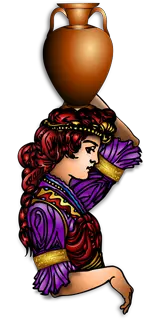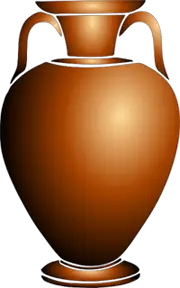Ancient Greek Women
The lives of women in Ancient Greece were very different from women in modern countries today. Although the Greek people worshipped powerful goddesses as well as gods, the role of women in society was mostly confined to the home.

Greek Women and Marriage
In most modern countries today, romantic love is the reason that people marry, but at the time period of 400 BCE, marriages were arranged. Fathers had legal control over their daughters until a suitable match was found for them. Most girls married around the age of fifteen. This seems to be a young age but the average lifespan at that time was around 35-40 years.
Once married, women were ruled by their husbands. Greek men admired women for their roles as wives and mothers, but they frequently thought that women were too emotional. Greek men prided themselves on their reasoning abilities. Men were seen as rational and women were seen as irrational.

The Greek Home
 In many Greek homes, the top floors were the domain of the women in the household. Women were not permitted to enter the room where their husbands had dinner with their friends. With the exception of this male-dominated room, the woman of the house had freedom within her household.
In many Greek homes, the top floors were the domain of the women in the household. Women were not permitted to enter the room where their husbands had dinner with their friends. With the exception of this male-dominated room, the woman of the house had freedom within her household.
If she was married to a man who was wealthy, she had slaves to do the heavy work, and she was able to take time to travel outside her home to visit friends and relatives.
If she was married to a man who didn’t have wealth, she might have had to take a job outside the home to make income for the family. She might have worked in a shop or as a servant for a wealthy family. Some women managed inns or learned to make cloth for garments.
Duties of rural women would include work on the farm. They harvested olives and fruits as well as gathered vegetables.
Women also went out to attend religious ceremonies and rituals to honor the gods and goddesses. These ceremonies were often held in temples that were designated for women only.

Women in the City-State of Sparta
In Sparta, life was different for girls than it was in other regions of Greece. Girls attended government schools and also played sports, which other Greek girls didn’t have the opportunity to do. Sparta needed soldiers so women who gave birth to male children were prized. Most women had slaves to handle the household chores.
Spartan men were so focused on warfare that, compared to other city-states, Spartan women had more freedom and independence. Around 400 BCE, two-fifths of all the land in Sparta was owned by women as compared to other city-states where all inheritances had to go through the male bloodline and only limited property could be owned by women.

The Feast of Thesmophoria
The feast of Thesmophoria was a three-day religious festival attended by married women. The event was created to honor the goddesses Persephone and Demeter. This festival was celebrated in many cities. In the city of Athens, women gathered on the Pnyx, which was the hill designated for political discussions held by men.
The women fasted for one day to demonstrate their devotion to the gods and goddesses. They shouted insults at each other as a way to amuse the gods and win their favor. If they won the favor of the gods and goddesses, the crops would be good. This important religious festival also provided a social outlet for women who were still nursing very young children.

Beauty and Fashion
 Vase scenes and other art objects of that era show women in the courtyard of the house. In sunny weather women would sit in the roofed-over segments of the courtyard. It was important for their skin to stay out of the sun, since the ideal beauty was one who had a pale complexion.
Vase scenes and other art objects of that era show women in the courtyard of the house. In sunny weather women would sit in the roofed-over segments of the courtyard. It was important for their skin to stay out of the sun, since the ideal beauty was one who had a pale complexion.
Since the weather was warm for a good portion of the year, Greek women wore light, loose-fitting clothes. Most of their tunics or chitons were made from big square pieces of linen. The wealthy had colorful fabric while the poor had plain cloth. They used pins to hold the fabric fastened and draped it in folds down to their ankles.
Inside the home they went barefoot, but often wore sandals to travel outdoors. Jewelry was also popular in ancient Greece. Women wore elaborate bracelets, necklaces, and earrings.
To enhance an already pale complexion, women applied white lead to their faces to lighten their complexions. They didn’t realize the toxicity of lead at that time. Chalk was used too but it wore off too quickly. Women decorated their eyes with dark powder and connected eyebrows were considered fashionable. They applied red powder to their cheeks as a blush.
Women’s hairstyles were quite elaborate. Wealthy women had long hair, which they braided and arranged in buns or tied back. They wore metal headbands or tiaras and elaborate netting to hold their braids in place.



